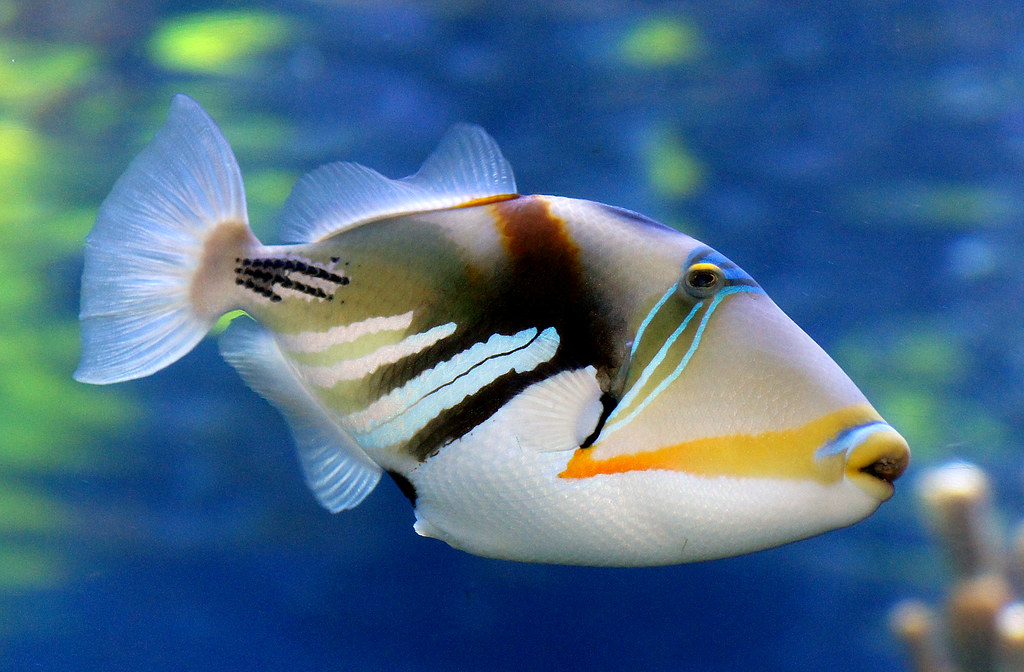All About Triggerfish: The Curious, Colorful Ocean Dweller
Triggerfish are indeed among the most interesting species in the world of marine life. They are characterized by having vivid coloration as well as fascinating activity patterns that attract the eyes of divers and marine lovers. They are more than what you might think. Let’s dive in!
Triggerfish are rather interesting inhabitants of the ocean. Due to their bright colors and distinctive movements, people who dive enjoy their styles. But due to their tendency to live in such regions and their highly dangerous bite, one should better observe them from a distance. With regard to diving trips or simply as a dish, there is not only meat in the triggerfish’s baggage.

Scientific Information about Trigger Fish
Triggerfish belong to the family Balistidae, and there are around 40 species with unique features and behaviors. Here’s a closer look at their scientific classification:
- Kingdom: Animalia
- Phylum: Chordata
- Class: Actinopterygii
- Order: Tetraodontiformes
- Family: Balistidae
Physical Characteristics
Body Structure: All the members of the triggerfish family possess a fusiform body with a flat abdomen, which is rather useful in exploring narrow gullets of coral- galleries. They possess large, sharp and effective carnivoral teeth and hefty jaw muscles adapted to crushing obstinate shells and other hard-skin coaches.
Fins: The name “triggerfish” comes from their unique dorsal fin mechanism. They can lock their first dorsal fin spine in an upright position using a second spine, which acts like a “trigger.” This helps them wedge into crevices and deter predators.
Colors and Patterns: Triggerfish have bright, well-defined colors and distinct patterns that may include bright blue and yellow, to name but a few, as well as complex patterns that indicate the environment they dwell in.
Habitat and Distribution
Triggerfish belong to the warming line of fishes and are mostly distributed in the tropical and subtropical regions of the world’s oceans. This species resides mainly in coral reefs, in crevices that are found on rocky outcrop areas, and in sandy grounds, It feeds mainly in areas that are up to a depth of 165 feet. This species can exist in the areas of the Indo-Pacific, Caribbean Sea, and Atlantic Oceans.
Behavior and Ecology
Diet: Triggerfish are enviromenentatersists feeding on small fish, sea urchins, shrimp and crabs, mollusks, jellyfish, and types of seaweed. Their teeth are rather robust, which helps them crack the shells of the prey they perish for.
Reproduction: Triggerfish during the breeding season can be aggressive This is due to the fact that breeding season is a time when they are actively searching for mates. Fish are oviparous, which means that they produce eggs. The female digs holes in the sand and then fiercely defends the eggs when they are laid.
Territoriality: Male and female triggerfish are unique animals when it comes to matters of territory in this period; they are very protective of their territory. They can turn nasty with intruders, and this includes people. This is especially the case with species such as the Titan Trigger Fish.
Notable Species
- Titan Triggerfish (Balistoides viridescens): The largest species, known for its aggressive behavior, can reach up to 30 inches in length.
- Queen Triggerfish (Balistes vetula): Known for its vibrant colors and unique patterns, commonly found in the Atlantic Ocean.
- Clown Triggerfish (Balistoides conspicillum): Recognized for its striking black body with white spots and yellow mouth, commonly found in the Indo-Pacific region.
Ecological Importance
Triggerfish help maintain coral reef health by preying on sea urchins and other invertebrates that can damage coral. This keeps the ecosystem balanced.
Conservation Status
While many triggerfish species are not endangered, they face threats from overfishing, habitat destruction, and climate change. Conservation efforts are essential to protecting these vital marine creatures.

Reef Trigger Fish: A Colorful Coral Resident
The Reef Triggerfish is another beautiful fish species, and its scientific name is Rhinecanthus rectangulus, though in Hawaii, it is known as Humuhumunukunukupuaʻa. These fish are rather easy to identify with the help of their bright and rather ostentatious colors, as well as various body shapes and patterns. They can normally be up to 25 centimeters in size.
Reef Triggerfish are primarily found within the coral reef zone and, more specifically, up to depths of 100 feet, mainly over regions with hard bottom structures consisting mainly of rocks and corals. They feed on invertebrates, small crustaceans, algae, and, at times, small fish, all of which can be described as non-vegetarian. They have powerful jaws and shaped teeth, which enable them to crack the shells of prey.
These fish are territorial, especially when it is breeding time of the year. The female digs up holes in the sand to lay on and confines herself to the hole, awaiting the eggs to hatch. Reef triggerfish are useful fish that are involved in the killing of sea urchins and any other invertebrate that may cause harm to coral.
In Hawaii, the Reef Triggerfish does have social and cultural meaning associated with it; it is colorful to represent the fish of Hawaii. Their unique behavior and vital contribution to the formation of ecology make them an interesting topic in marine biology.

Niger Trigger Fish: The Deep Blue Beauty
The Niger Triggerfish, otherwise commonly known as Odonus niger, is appreciated for its deep blue to purple skin coloring and red-stained teeth. Popularly known as red-toothed triggerfish, this fish has a beautiful elongated dorsal and anal fin, giving it perfect silky streamers. Both of these fish mortalities can reach up to twenty inches in length.
Niger Triggerfish inhabit outer reef slopes and drop-offs, 10 to 100 feet deep, often in fast-flowing currents, in plankton-rich waters. Inhabitants of the Indo-Pacific region range from the Red Sea and east Africa up to Hawaii and the Marquesas Islands of French Polynesia.
These fish are omnivores; they mainly consume plankton, small insects, and water plants or algae in their natural habitat. This species is known for being more social and prefers to swim in large groups; this fully explains why they are easily spotted in the large ocean. C1 The visibility of the Niger Triggerfish as well as their way of life make the species very interesting to watch.
Is a Triggerfish Bite Poisonous?
Triggerfish bites can be painful, but they are generally not poisonous. However, it’s important to clean any bite wounds properly to avoid infection.
Why Is It Called a Triggerfish?
Triggerfish get their name from their unique dorsal fin mechanism. When threatened, they can “lock” their first dorsal spine upright by using a second spine, much like a trigger. This helps them wedge themselves into tight spaces and avoid predators.
Are Triggerfish Friendly?
These fish can be rather aggressive and may go into protective mode, especially during mating periods. Some of them may not even look friendly in any way but are best watched for the fun of it from a distance.
Do Triggerfish Eat Other Fish?
Yes, triggerfish are obligate narratives, and they eat other fish, crustaceans, and algae, among other things. They have equally powerful jaws and strong teeth, especially when used to crushing hard outer shells of prey.
Things to Know About Triggerfish
Taste
Triggerfish Taste: To my surprise, triggerfish are very tasty fish! Their flesh is white, flaky, and rather delicate in taste, similar to crab or lobster, as some of their consumers argue.
The Best Way to Eat Triggerfish: These include grilling, baking, frying, and other intensive heat application processes. This is because the meat does not easily break down when subjected to heat, and combining it with different spices is also agreeable.
Is triggerfish healthy? Yes, they are a health-beneficial fish to be consumed by people or prepared for eating. These foods contain little fat, yet they are rich in proteins and therefore recommended in one’s diet.
How bad is a triggerfish bite?
The private venture of triggerfish makes them capable of delivering painful bites because of their powerful jaws as well as sharp teeth. Although they are not venomous, their stings can be rather painful, and one should refrain from provoking them to avoid infections.
Triggerfish Species
Trifin is a family of fish, and this family was classified into about 40 different branches, making it a different species of triggerfish. A few of the most common types of this fish are the Titan Triggerfish, Queen Triggerfish, and Clown Triggerfish. The characteristics of each of these species are different, and the way they conduct their lives is different as well.
Triggerfish Attack
The Titan Triggerfish, as well as other members of this family, are ironically aggressive fish, especially when they are guarding eggs. This means they can dish out a large punch if they are upset.
Triggerfish Teeth
Triggerfish have conical and powerful jaws with cannons that are suited to cracking the shells of their prey. These teeth are also useful in defense against predators as well as in defending an individual’s territory or the territory of a group or pride.
Why are triggerfish called triggerfish?
Their name is derived from their dorsal ‘trigger’ on their back, which they use to lock them into crevices or a crevice to fend off any predator.
Titan Triggerfish Attack
The Titan Triggerfish catches the attention of other fish and stands out for its hostile nature. In relation to these fish, divers sometimes claim to be attacked or followed by these fish, particularly during the breeding season.
Triggerfish Bite
A triggerfish bite can be quite painful due to their strong jaws and sharp teeth. Always exercise caution when near these fish, particularly if they appear agitated.
Triggerfish Size
Triggerfish can vary in size, with most species ranging from 10 to 20 inches long. The largest, the Titan Triggerfish, can grow up to 30 inches in length.
Triggerfish Prey
Triggerfish have a varied diet that includes small fish, sea urchins, crustaceans, and algae. They use their strong jaws to break open hard shells and access their prey.
Checkout More about other Fishes : About Fishes

